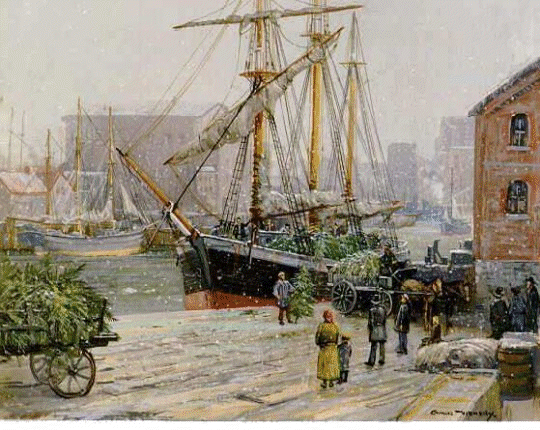ROUSE SIMMONS written by: Allan Holden


By the turn of the century, many of the wooden ships would be cut down for barges to be towed by the powerful and more dependable steamships that would soon replace them.
A man named Herman Schuenermann saw the vast number of wooden schooners retired and tied to abandoned docks. With his love for Christmas, he came up with an idea to make Christmas a little brighter for the families in his favorite port, Chicago. His plan made good business sense besides.
With a large assortment of schooners available, Captain Schuenemann looked for the strongest and best vessel to meet his requirements. The ship that most impressed him was the 125 foot 200 ton Rouse Simmons. The Simmons had been hauling cargo between the ports of Chicago and Muskegon, Michigan, and was in very good condition.
Captain Schuenemann and his brother August had purchased 240 acres near Thompson's Harbor, Michigan, where he and his brother August cared for a huge crop of fine spruce Christmas trees. During the summer months, the Simmons was put to work transporting lumber between northern Wisconsin and Michigan ports. Then at the end of the shipping season the ship would be loaded with Christmas trees for the trip home. For the first two years business was booming. Captain Schuenemann sold his trees for the lowest prices of anyone in Chicago. Low prices combined with the novelty of buying trees right off the deck of this much loved and beautiful ship made business boom. Many of the trees were given away to needy families and churches.
Each year there seemed to be a need for more trees! No doubt the captain had plans of putting another retired schooner back to work and why not, after all they were plentiful ... he surely had a good thing going.
It was said that with the crew's method of bundling the trees, the Simmons could carry 5,000 trees below deck in her holds. But loading for the return trip the last time, the captain ordered almost an extra 500 trees to be lashed to the deck--- some were even tied to the masts. Checking her profile in the water, the captain was confident that his faithful vessel carried the additional weight nicely.
November is the deadliest month on the Great Lakes. Some who watched as steam tugs guided the Simmons toward open water, worried for her safety. The wind had already started to grow colder and stronger as the western sky darkened. Within an hour of leaving port, it started to snow and the wind grew colder still. The captain ordered the crew to bring in most of the sail as the heavy ship crashed into the waves.... it was going to be a long night.
Just the year before, the Simmons went through a complete re-caulking, yet the heavy load on the inside and the brutal waves on the outside tore at her seams. When the captain realized the amount of water the Simmons had taken on, he knew that steps had to be taken to lighten their load. The ship was low in the water by this time and the task of unloosing trees with waves crashing over the deck proved to be deadly. Soon the captain ordered a crewman to hoist the distress flags. When the crewman returned to the captain , he reported that two of the crew, Endwald and his dear friend Steve, were washed overboard. The captain wrote a note and sealed it in a bottle just in case!
The watchmen on duty at the Kewaunee Life Saving Station spotted the Simmons with distress flags flying, but the ship had already drifted a good deal south of them before she was spotted. The Coast Guard station at Kewaunee wired the Two Rivers, Wisconsin, station and told them of their sighting.
As fast as possible the Life Savers launched their power boat, Tuscarora, to intercept the Simmons. By now the storm was what weather professionals today call a mid-latitude cyclone. Once the Simmons was spotted by the Life Savers, the motor launch was turned in her direction. When the Life Savers were less than a quarter mile from the Simmons, they could see that she was covered with ice and tattered. They also noted much of the rigging and sail were gone. When they were less than an eighth mile from the ship, the snow came down so hard that the rescue launch lost site of the Simmons in white-out conditions. By the time the heavy curtain of snow passed, the Simmons had disappeared.
Christmas in Chicago that year was a somber one. But it wasn't to stay that way for long. The following year and the next twenty two years to follow, the Captain's Widow Barbara Schuenermann made the voyage and carried on the tradition in memory of her beloved husband and his love for the Christ of Christmas.
In 1971 while inspecting another wreck, scuba divers happened upon the Simmons. It still contains hundreds of Christmas trees--- obviously without needles. Two of the trees were brought to Milwaukee where one is displayed in the lobby of the Marine National Exchange Bank. The anchor of the Rouse Simmons stands today at the entrance to the Milwaukee Yacht Club.
Oh yes, the bottle was found and the note inside was clearly in Captain Schueneman's hand writing. His last message was "Everybody good-by. I guess we are through. Leaking bad. Endwald and Steve fell overboard. God help us."